September 8, 2020
A Honey of a Recipe
Honey-Glazed Roast Pork with Glazed Apples
Thinking about honey reminded me of a dish I had at a Boston restaurant one fall.
We spent a crisp, sunny afternoon walking the Freedom Trail and ended up at charming little restaurant. The special was a pork roast glazed with honey and cooked with fragrant apples. This recipe is very similar to that dish. Cider would be delicious with this! If you prefer wine, I would suggest an off-dry, fruity, low tannin wine to pair with this dish. Perhaps a chardonnay or a pinot noir. It makes four sweet and savory servings.
Honey-Glazed Roast Pork with Apples
2 ½ lb. pork loin roast, tied
2 tablespoons honey
4 sprigs rosemary
4 sprigs thyme
6 tablespoons unsalted butter, cubed
2 medium yellow onions cut into 8 wedges each
2/3 cup dry apple cider
5 tart apples, cored and quartered
Preheat oven to 350 degrees. Place the pork in a large roasting pan and season with salt and pepper. Drizzle the honey over the pork, then arrange the herbs on top. Scatter cubes of butter over the pork. Arrange the onions around the pork. Pour the cider into the pan and bake until a thermometer reads 120, about 45 minutes. Scatter the apples around the pork and bake until the fruit is tender and the pork is golden brown. The thermometer should reach 160. Remove from the oven and let rest for 20 minutes. To serve, cut the pork into slices and serve with the baked apples and onions. Drizzle with pan juices before serving.
August 31, 2020
National Park Campgrounds and Picnic Areas to Reopen
September 3, 2020 marks the reopening day for campgrounds and picnic areas in the Great Smoky Mountains National Park (GSMNP). The reopening follows guidance from the White House, Centers for Disease Control and Prevention (CDC), and state and local public health authorities. The National Park Service is closely monitoring the covid-19 pandemic. They have developed a phased approach to increasing park access.
Campgrounds and Picnic Areas
The following areas will be accessible beginning on September 3:
- Abrams Creek, Balsam Mountain, Big Creek, Cataloochee, and Cosby Campgrounds
- Big Creek, Cataloochee, Round Bottom, and Tow String Horse Camps
- Heintooga and Look Rock Picnic Areas
- Little Greenbrier Road
Please remember that the following areas continue to be open:
- All Park trails, backcountry campsites, and shelters
- All visitor centers and restrooms
- Cable Mill in Cades Cove and Mingus Mill near Oconaluftee
- Cades Cove, Elkmont, Deep Creek, and Smokemont Campgrounds
- Anthony Creek Horse Camp
- Big Creek, Cades Cove, Chimney Tops, Collins Creek, Cosby, Deep Creek, Greenbrier, and Metcalf Bottoms Picnic Areas
- Spence Cabin and all Picnic Pavilions for day-use rental
- Concession operations: LeConte Lodge, Sugarlands Riding Stables, Cades Cove Riding Stables, Cades Cove Campstore, and Smokemont Riding Stables
The Appalachian Clubhouse remains closed.
According to Park Superintendent Cassius Cash, “We are pleased to be able to offer more opportunities for visitors to disperse and recreate in the park in time for the Labor Day holiday and our busy fall season. The Park has experienced record visitation this summer and we want to remind everyone that we need your help more than ever to keep the Park protected and clean.”
Park officials suggest you choose trails and overlooks without congested parking areas. Visiting early in the morning will help you view the Park in less crowded conditions. Remember to maintain distance from other visitors and wear a face covering when you cannot maintain physical distance.
Buckhorn Inn guests may ask staff to recommend some of our favorite hiking trails. We also can pack you a hearty sack lunch for $10 to enjoy at one of the picnic areas.
August 25, 2020
Cherry Tomatoes Fresh From Buckhorn Inn Garden
Don’t you love those luscious, sweet, end-of-summer cherry tomatoes? They pop in your mouth with such bright flavor. We have grown several varieties of these small tomatoes here at Buckhorn Inn. One of the most prolific this year was our heirloom Yellow Pear tomatoes. They fruit is bright yellow and they are deliciously tangy. We also have had great success with Shimmer, Honeycomb, Napa Grape, Mighty Sweet, and Black Pearl. They look beautiful served together in a salad! Our chefs also have enjoyed using them in “farmer’s omelets” showcasing our garden-fresh veggies. http://www.burpee.com/vegetables
Tomato History
Food historians believe cherry tomatoes are a modern version of South American wild tomatoes. According to archeological evidence, Central American farmers grew the first domestic strains of these small tomatoes. The Incas and Aztecs farmed tiny pea-size fruit around 700 A.D. You may not realize that large tomatoes are actually a mutation of the cherry varieties. The first cultivated tomatoes were berry-small and housed only two cavities for seeds.
We do not know who gets credit for bringing tomatoes to Europe. The first description of small tomatoes in print appears in a 1623 illustrated book of plants. The fruits reached wild popularity in the 1970s when British chain Marks & Spencer worked with local growers and food scientists to develop a new cherry tomato that was very sweet and shelf-stable.
We hope you are enjoying a bountiful crop! If you have more tomatoes than you can use fresh, why not oven dry some of them? That is what we have been doing. These little flavor bombs are great for salads, pasta topping, or snacking. They burst with intense tomato flavor. And it couldn’t be more easy.
Oven-Dried Cherry Tomatoes
35 cherry tomatoes
1 Tablespoon of salt
Herbs, optional
Preheat oven to 200 degrees. Line a baking sheet with parchment paper. Cut tomatoes in half horizontally and place on the sheet, sides touching and cut side up. Sprinkle with salt and let sit about 30 minutes. Sprinkle with chopped basil, oregano, or parsley. Bake for 2 1/2 to 3 hours until the halves are about 3/4 of their original size and are deep red in color. You may keep them for a month or so in an airtight container in the refrigerator or they may be frozen.
August 17, 2020
Wild Turkeys Alive and Well in Tennessee
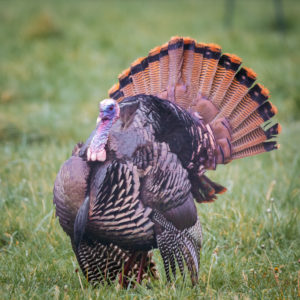
A male eastern wild turkey spreading his tail feathers on an overcast morning in Cades Cove, Tennessee
At Buckhorn Inn we have two wild turkeys who frequent the area below one of our bird feeders. We were interested to learn more about them, and thought you might be, too.
According to the Tennessee Wildlife Resources Agency, http://www.tn.gov/twra/wildlife/birds, wild turkeys are the largest birds nesting in Tennessee. These birds were a very important food source to Native Americans and early settlers. Unfortunately, over-hunting and land clearing reduced the numbers of this species. Wildlife management techniques have reestablished the birds through their historic range.
The birds are found in mature woodlands or fields. They eat acorns, nuts, seeds, fruits, insects, buds, fern fronds, and salamanders. The males begin strutting to attract females in late winter and early spring. The female, with no help from the male it should be noted, makes a ground nest and lines it with with leaves and grass. The nest is usually at the base of a tree or bush and hidden by thick vegetation. The female lays anywhere from 7 to 14 eggs and incubates them for about 28 days. The young leave the nest soon after hatching. The male young stay with the female until fall while the females remain with their mother until spring.
Fun Facts about Tennessee Wild Turkeys
- There are approximately 300,000 of the birds in Tennessee.
- The average male weighs 16.2 pounds and the female weighs 9.2 pounds.
- The male provides no care to the young.
- Several females and their broods may form flocks of 30 or more birds.
The birds can be seen throughout the Great Smoky Mountains National Park, most often in the lower elevations. They roost in trees, so you are less likely to see them in the evening. Good places to spot them are the open fields near the Sugarlands Visitor Center and the Cades Cove Loop Road. Or you may just see them hanging around Buckhorn Inn!
August 10, 2020
Sangria Is A Perfect Summer Refresher
Several guests have mentioned how much they used to enjoy the Chef’s Inspiration Sangria as a weekend special at Buckhorn Inn. While current challenges have prevented us from serving it this summer, we are prompted to share recipes with you.
Sangria is a drink which originated in 18th century Spain. The original version used red wine, hence the name which literally means “bloodletting” in Spanish. The punch was poplar in colonial America, but largely disappeared in the States by the early 20th century. The iced version of the drink was reintroduced to the U.S. through Spanish restaurants in the 1940’s. It achieved a wider popularity during the 1964 World’s Fair in New York.
Each region of Spain has its own version of this wine and fruit punch. The traditional version is made with red wine with a variety of fruits and sweeteners. Spanish Rioja wine, made from the Tempranillo grape, is a good choice. Recently a version of the drink made with white wine has become popular. Any type of dry white wine may be used. http://www.foodandwine.com/drinks/
Red Wine Sangria
1/2 cup water
1/2 cup sugar
2 bottles of dry red wine
1/2 cup brandy
1/2 cup orange juice
2 limes, sliced
1 lemon, sliced
1 orange sliced
Club soda
Ice cubes
Bring water and sugar to a boil. Cook 3 minutes or until the sugar is dissolved. Cool. In a large pitcher stir together wine, brandy, orange juice, and sugar syrup. Refrigerate, covered overnight. A few hours before serving, stir in sliced fruit. When ready to serve, fill glasses with ice. Fill glass 2/3 with sangria and top off with club soda. Garnish with fresh fruit and mint leaves. About 12 servings
White Wine Sangria
1 cup water
1 cup sugar
2 bottles dry white wine (unoaked Chardonnays or Chenin Blancs are good choices)
1/2 cup orange liqueur such as Cointreau
1 lemon, sliced
2 limes, sliced
2 oranges, sliced
Club Soda
Ice Cubes
Bring water and sugar to a boil. Simmer 5 minutes. Cool. Stir syrup, wine and liqueur together, cover and chill. Before serving pour wine into a pitcher. Stir in fruit. Serve over ice, topping each glass with the Club Soda. About 12 servings.
These recipes make great starts for your own experiments with different wines and fruits. We would love to see the recipe you develop for your very own house sangria!
August 3, 2020
Pittman Center Has Become A Bee City!
Our community of Pittman Center has joined communities across the country to call attention to an important issue. Affiliates of Bee City USA are working to protect pollinators. So far 111 cities have signed up to raise awareness, establish and enhance habitats, and celebrate the efforts of volunteer leaders.
Honey bees and other pollinators are facing threats at increasing rates. According to Bee City USA http://www.beecityusa.org one of every three bites of food that we eat is thanks to insect pollination. In fact, 90% of all plants and trees rely on pollinators for the survival of their species. That is why we must be concerned with bees disappearing because of loss of habitat, diseases and parasites, and inappropriate pesticide use. Some experts estimate that U.S. honey bee populations are declining at an annual rate of as much as 44%.
Pittman Center Approves Resolution
In May 2020 the town of Pittman Center approved a resolution naming the town an affiliate of Bee City USA. The town’s Tree Board will oversee the Bee City USA program. The town will host at least one educational event or pollinator habitat planting each year to showcase the community’s commitment. There also are plans to create or expand a pollinator-friendly habitat on public and private land. The Tree Board also will create and adopt an integrated pest management plan. This plan will be designed to prevent pest problems, reduce pesticide use, and expand the use of non-chemical pest management methods.
At the Buckhorn Inn, we are delighted with this new program. This is the second summer for our honey bee hives. We report that Queens Violet and Catherine and their minions are healthy and happy. You can watch them at work in our vegetable and flower gardens. When the nectar is flowing they are especially busy in St. Cordelia’s garden. We hope you have a chance to watch them at work.
July 27, 2020
Elk in the Great Smoky Mountains
Have you seen elk in the Great Smoky Mountains National Park? Our area is home to nearly 200 of the magnificent animals.
Elks are awe-inspiring creatures. The males can weigh up to 700 pounds. The females fiercely defend their offspring and may charge challengers. For a few weeks during the fall mating season, the males, with fully developed racks, bugle and fight to get the attention of the females. The females gather in groups, called harems, on the edge of the fighting fields.
Large herds of elk once roamed along the Appalachian Mountain Range from George to Canada. But, due to overhunting and habitat destruction, the species disappeared from the region in the 1800’s. The National Park Service determined it was appropriate to bring back a native species that had been eliminated from park lands. A small herd of 25 of the animals was reintroduced to the park in 2001. As part of the experiment, the animals were outfitted with radio collars. In 2002 another 27 animals were brought to the area. This reintroduction has been very successful and today the population flourishes.
Best Places to View Elk
The elks have become celebrities, attracting many visitors each year. Most of the elk can be found in the Cataloochee area in the southeastern area of the park. They may be active on cloudy summer days and before or after storms. But the best time to spot them is early morning or late evening. The Park Service reminds you to enjoy the animals from a distance and use binoculars for close-up views. In fact, approaching within 150 feet, or any distance that disturbs the animals, is illegal in the park. To avoid fines and arrest, do not enter the field. Remain by the roadside, please. http://www.nps.gov
Please send your pictures to [email protected]. We would love to share them with other guests!
July 20, 2020
Bees Beard to Beat the Heat
One of our guests pointed to our honeybees clustered on the outside of the hive and said it looked like a “beard”. They wondered why the bees would do this. We have an answer!
“Bearding” is the term which refers to bees accumulating at the front of the hive. They appear calm and fan their wings in unison. They are likely to do this on hot and humid days. By clustering outside they provide more space inside the hive to keep the temperature and humidity within acceptable ranges. Raising brood requires temperatures between 90 and 97 degrees F. They remove their own body heat from the hive to lower the temperature. They also use their wings to push cooler air into the entrance, lowering the temperature even more. The proper humidity is necessary for nectar to evaporate and become honey.
Bee keepers sometimes confuse bearding bees with those getting ready to swarm. But if it is a hot and humid day, chances are good that they are merely bearding. Bearding bees also face the same direction as they fan. This helps cool down the temperature of the hive.
Healthy Bees Beard
According to Kelley Bees http://www.kelleybees.com/blog Bearding is a sign of a strong bee colony that is in good health. It is an indication that the hive contains a good number of bees and that they are preparing for winter by keeping the honey at the correct temperature.
Bees may beard for weeks during the hottest part of the summer. The workers are very skilled at temperature control. Worker bees may also spread water on the rims of cells to set up cooling by evaporation. They can create air currents by fanning their wings. And they adjust the temperature by expanding and contracting the size of the cluster.
We help the bees by providing a source of fresh, clean water. A hive of bees can use as much as a liter of water in a day! We also have painted the hives white so that the sunlight will be reflected, not absorbed.
We are fascinated by our honey bees and are glad that our guests are interested as well!
July 13, 2020
Celebrate Summer with Pesto
This is the time of summer when the basil in our garden here at Buckhorn is ready to pick. Combining it with dairy creates the perfect appetizer for a summer evening out on the patio. This recipe is from the 1988 edition of Easy Entertaining with Marlene Sorosky. I have made it many times and served it with a variety of crackers. A good wine pairing might be an Australian sauvignon blanc. The green, herbaceous notes of the wine complements the pesto flavors and the bright acidity will act as a palate cleanser. This recipe serves 16.
PESTO
2 large garlic cloves, peeled
2 cups (about 2 ounces) basil leaves (note: if you blanch them a few seconds in boiling water and then plunge in ice water the basil leaves will retain their emerald green hue)
2/3 cup grated parmesan cheese
2/3 cup chopped walnuts
¼ cup olive oil
CHEESECAKE
11 ounces cream cheese at room temperature
¾ cup ricotta cheese (about 6 ounces)
8 ounces goat cheese
3 eggs, at room temperature
½ cup sour cream
To make the pesto, mince garlic in a food processor. Add basil, cheese, and walnuts and process until ground. Add oil and process to a thick paste.
To make cheesecake, butter an 8 ½” springform pan. Preheat oven to 350 F. Mix together cream cheese, ricotta, and goat cheese until well blended. Mix in eggs until thoroughly incorporated. Add sour cream and process until well blended. Pour into springform. Bake for 45 to 55 minutes. The top will be golden and the center will still jiggle. Remove to rack and cool completely. When ready to serve, remove sides of pan and spread pesto evenly over the top. Sun dried tomato strips make a lovely garnish. Sit back and wait for the compliments!
May 29, 2020
Smoky Mountains Are Home to Amazing Creatures!
The Great Smoky Mountains contain a myriad of flora and fauna. Some of you may have seen this little critter we photographed and posted on our Facebook page. We were eager to learn more about it. And just in time, the May issue of Smokies Live hit our inbox. This is a publication of the Great Smoky Mountains Association and contains well-researched articles on a myriad of topics. One such article is “Permanent Camp: Land Snails” http://www.smokiesinformation.org. Thanks to George Ellison for this interesting article. And we appreciate the beautiful illustration by Elizabeth Ellison.
The article identifies land snails as terrestrial gastropods in the phylum Mollusca. Worldwide, there are more than 100,000 members of the land snail species. About 150 of these can be found in our very own National Park! Land snails are fascinating to watch. They move by muscular contraction. The taller of their two sets of tentacles have eyes on their tips. The shorter set enables the snail to smell.
Where Can You Find Snails in the Great Smoky Mountains?
Just about everywhere, according to the article. They prefer moist, shady conditions. The article quotes Dan and Judy Dourson (authors of Land Snails of the Great Smoky Mountains). “The base of large diameter tree species such as black and butternut walnut can sometimes yield high numbers of land snails.”
The Great Smoky Mountains Association (GSMA) is a nonprofit that supports the preservation of the Park. They offer many resources to enhance public understanding and appreciation of the Park through education, interpretation and research. Membership in the GSMA includes subscriptions to their print magazine and electronic newsletters. Members also are entitled to shopping discounts at visitor center stores. We encourage you to consider membership in the GSMA and join us in becoming stewards of the Great Smoky Mountains National Park.



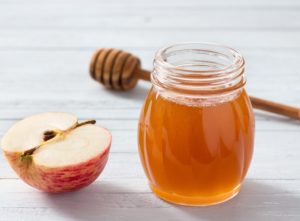
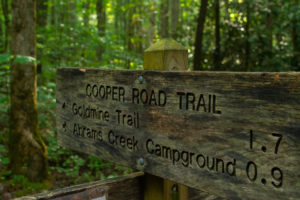
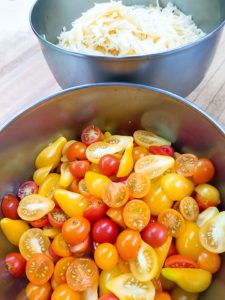

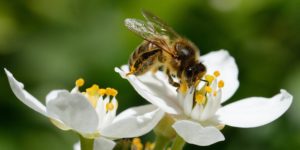
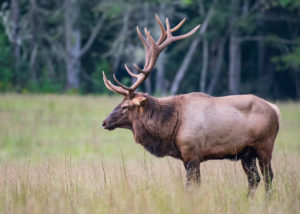
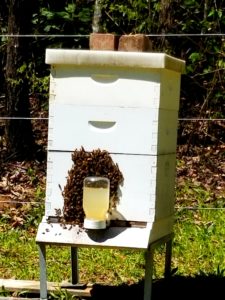
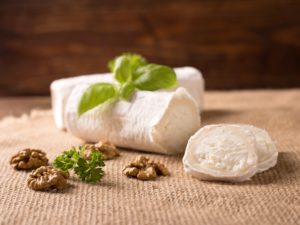
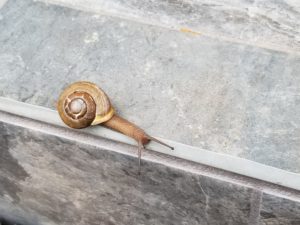

Gatlinburg Weather
Click for weather forecast